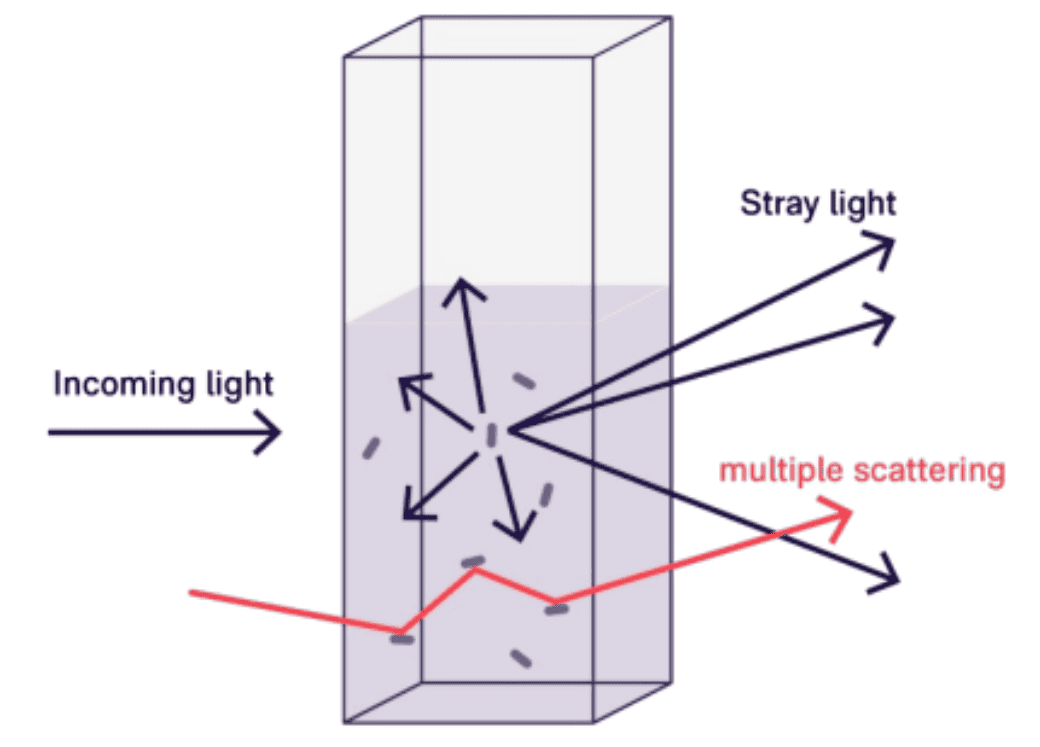Understanding OD600: Principle and Considerations
Optical Density at 600 nm (OD600) is a widely used spectroscopic method for estimating the concentration of bacterial cells in a culture. This method measures the absorbance or optical density of a bacterial suspension at a wavelength of 600 nanometers, which corresponds to the near-ultraviolet region of light. The wavelength 600 nm is typically chosen because it offers an acceptable tradeoff between signal strength and specificity where most of the light “loss” is caused by light scattering and not by pigment absorption. The fundamental principle behind OD600 is the scattering and absorption of light by bacterial cells, both live and dead, as well as any particles in the samle. The OD600 reading provides an indirect estimate of the cell density in a sample.

Applications of OD600
OD600 is predominantly used in two applications:
- Growth curves: By measuring OD600 at regular intervals, researchers can construct bacterial growth curves, which help in understanding the growth phase of the culture (lag, log, stationary, and death phases).
- Culture standardization: OD600 measurements allow researchers to standardize the amount of bacteria used in experiments, ensuring consistency across tests and replicates
The primary reason for employing OD600 is its fast time-to-result and relatively low cost. However, the primary parameter used to assess with OD600 is the cell concentration, and the quality of data provided by OD600 is oftentimes dubious, as the method is strongly dependent on many other factors than just the number of cells in the sample.
Considerations and limitations
There are several pitfalls and downsides to using OD600 to assess cell concentrations:
- OD600 does not differentiate between viable bacteria, dead bacteria, and other particles: If the medium contains a background of non-bacterial particles or a high concentration of dead cells, this could result in misleading results. This is particularly an issue in fermentation processes where cells are stressed, as any dead cells affect the OD600 results..
- The most overlooked pitfall of OD600 is that it is severely dependent on the size of the bacterial cells: Any changes in morphology during a growth curve will influence the ratio between OD600 and cell counts. Furthermore, even when cell division has stopped, the OD600 values may continue to change due to the cells adjusting morphologically to the new conditions.
- OD600 provides a number with an arbitrary unit: It does not provide true bacterial concentrations unless laborious OD600/CFU calibration curves are carried out.
- Many bacteria produce intracellular or extracellular compounds that affect the OD600 values: For example, pigments can vary over time with a fermentation, making the cell density estimate irregular over a growth curve.
Finally, spectrophotometer configurations vary and therefore the OD600 measurements from one device can not be compared directly with another device unless a calibration with measurement standards are performed.
Using direct cell counting instead of OD600
OD600 has been a dominating method for cell density estimates due to its simplicity and low-cost. However, as the boundaries for what can be achieved in biotechnology are increasing, more accurate, and equally fast, analytical methods are used to understand novel fermentation processes.
BactoBox is an accurate alternative to OD600, offering both speed and precision in its analysis. Our article on how BactoBox compares to OD600 can be downloaded here. Our comparison study clearly shows that BactoBox is a fast and reliable growth tracker for in-process samples of actively growing bacteria:
- BactoBox can differentiate viable and dead bacteria, and is not influenced by other particles: Due to being a direct cell counting method that enumerates bacteria on a single cell basis, other particles, and even dead cells, do not hinder BactoBox in providing accurate results.
- Cell concentrations with BactoBox are not influenced by changes in morphology: The correlation of BactoBox intact cell concentration relative to plate counts is consistent over the entire incubation period.
- BactoBox is more sensitive than the OD600 method: In practice this means that BactoBox can detect growth much sooner than OD600. The accuracy (similarity to the plate counts) of the BactoBox method is better than that of the OD600.
- BactoBox provides absolute concentrations for bacteria: The output for BactoBox is intact cells/mL, and not an arbitrary units that must be converted via calibration curves.
Conclusion
Conclusion
In conclusion, while OD600 has served as a fundamental tool for estimating bacterial cell concentrations, its limitations necessitate consideration of more advanced alternatives, especially in precision-critical applications. Despite its advantages of speed and cost-effectiveness, OD600's inability to differentiate between viable and non-viable cells, susceptibility to interference from non-cellular particles, and reliance on indirect measurements through arbitrary units can compromise the accuracy and reliability of data. This is particularly evident in complex fermentation processes and other biotechnological applications where precise monitoring of microbial cultures is essential.
As the demand for more accurate and detailed analysis grows, technologies like BactoBox represent a significant advancement, providing not only rapid and precise measurements but also the ability to deliver results that directly correlate with viable cell counts.
BactoBox's technology circumvents the traditional challenges faced by OD600, offering a direct cell counting method that enhances the reliability of bacterial enumeration and growth monitoring. This shift towards innovative technologies like BactoBox could redefine standard practices in microbial analysis, offering researchers and industry professionals a tool that aligns with the evolving needs of modern biotechnology. As we continue to push the boundaries of what is possible in microbial fermentation and other applications, the transition from traditional methods like OD600 to more sophisticated, accurate, and informative technologies will be pivotal in achieving unprecedented levels of precision and efficiency.
Enumerate Bacteria with BactoBox®
Enumerate Bacteria with BactoBox®
Enumerate Bacteria with BactoBox®
Please submit your contact and application details using the form below. A specialist from our team will contact you within one business day to discuss the technical compatibility of BactoBox® with your needs and outline potential trial opportunities. Alternatively, reach out directly to our CEO, Gustav.
Learn More or Request a Trial
Learn More or Request a Trial
Learn More or Request a Trial
Copyright © 2023 SBT Instruments A/S. All rights reserved.
